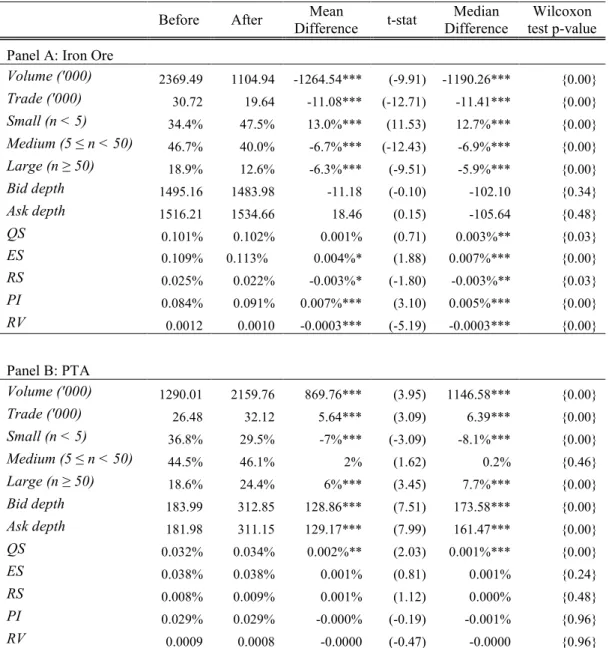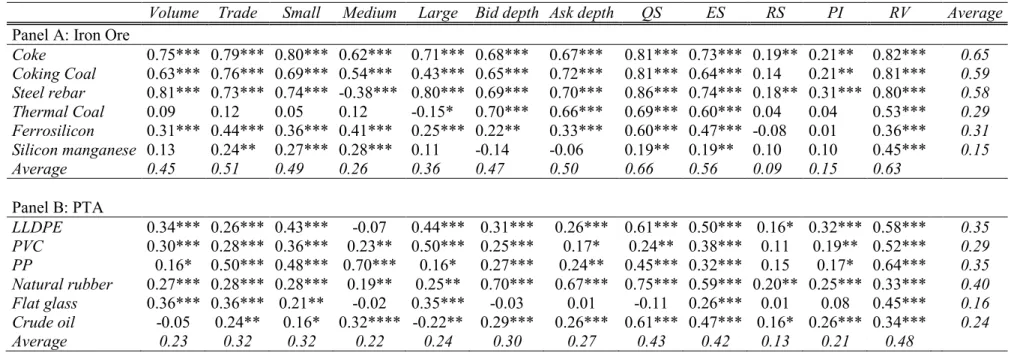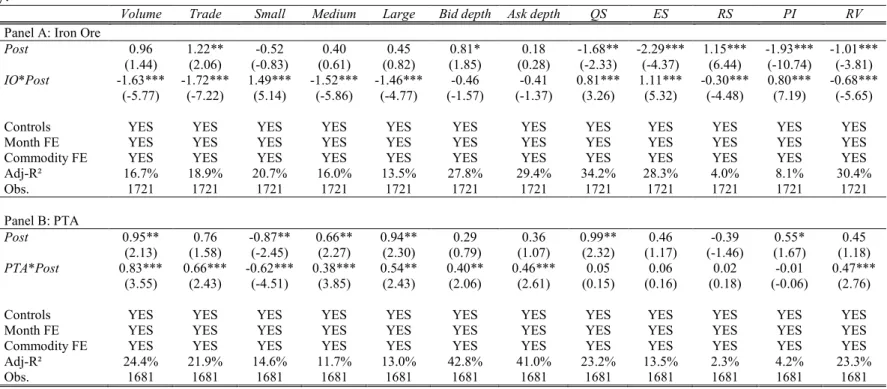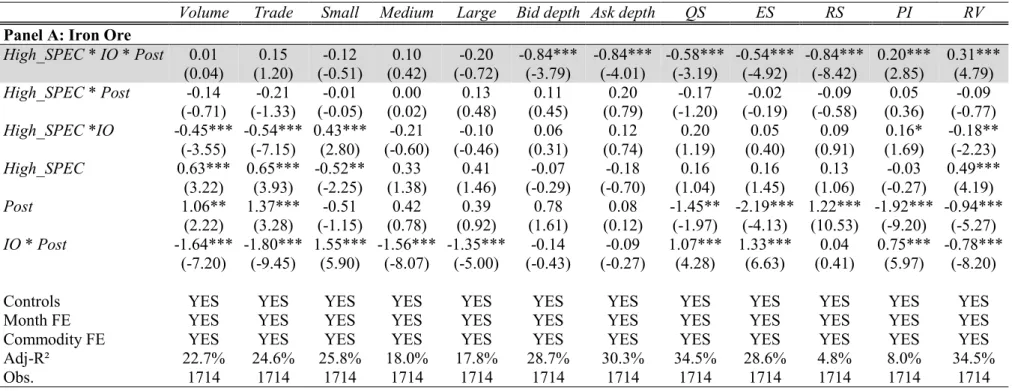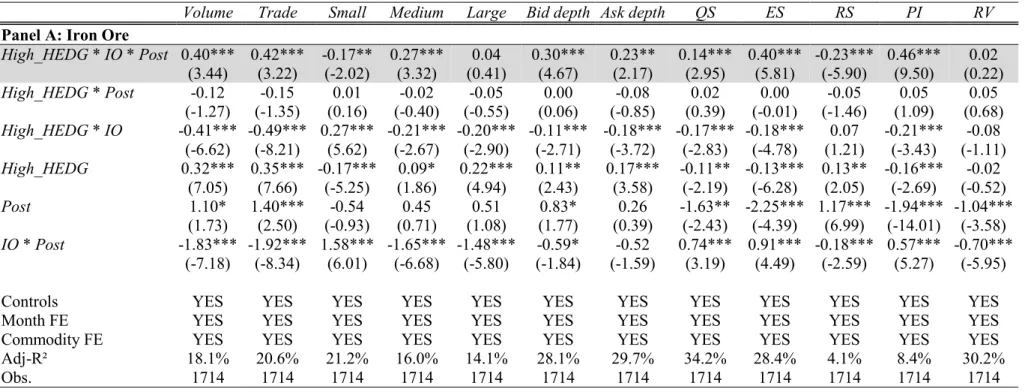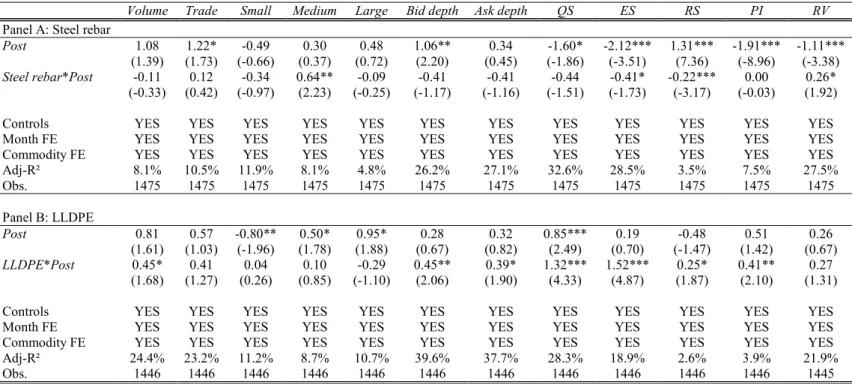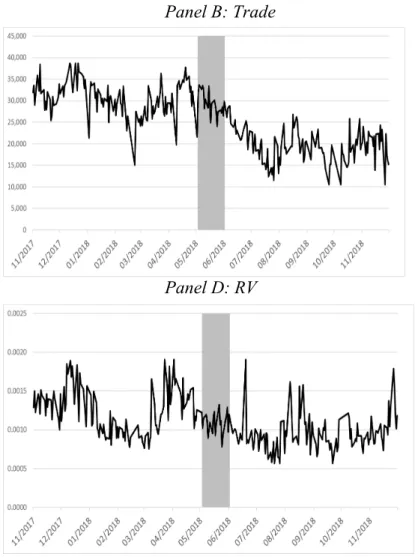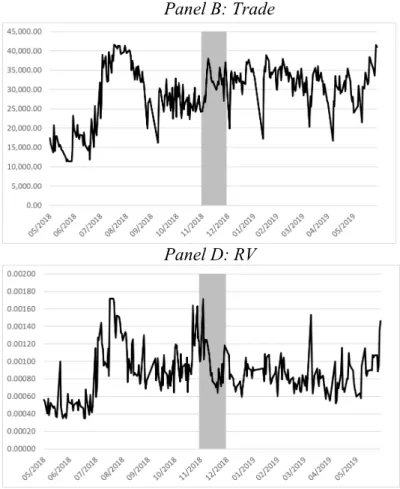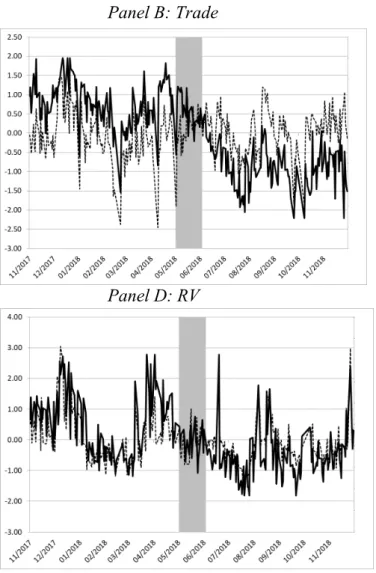The internationalization of the commodity futures market is another item on the agenda of ongoing efforts. This paper examines the impact on market quality of the entry of foreign investors into China's iron ore and PTA futures markets on May 5, 2018 and November 30, 2018, respectively. Needless to say, iron ore as a raw material has played an important role in the rapid expansion of the Chinese economy in recent decades.
To test the impact of the event on market quality, we need to use pre and post internationalization data. Trades are classified into buyer and seller initiated trades based on the prevailing quotes prior to the trade. Figures 1 and 2 present the daily evolution of volume, number of trades, effective spread and realized volatility in the event window for iron ore and PTA, respectively.
These figures provide us with a prima facie account of the impact of internationalization on market quality for iron ore and PTA, but we are interested in testing whether there is any causal relationship in these market quality measures due to the event of internationalization. The univariate approach shows how the impact of the internationalization on market characteristics varies from iron ore to PTA futures. 11 We drop the treated commodities dummy from the commodity fixed effect and the January dummy from the event window in the monthly effects.
Interestingly, DD can reveal the impact of the event on the realized volatility of PTA, which increased after the internationalization, which may be related to the higher market activity after.
What Explains the Results?
Panel A of Table 4 shows how the periods of high speculative activity in iron ore after internationalization came hand in hand with a decrease in the realized spread and an increase in the price impact, the net effect of which is a significant decrease in the effective spread (and quoted spread). So the 'new' speculators are helping to reduce the costs of trading in iron ore after internationalisation. Relatively speaking, the 'new' speculators in iron ore increase the realized volatility and reduce the bid/offer depth sharply.
Relatively speaking, the periods of high hedging activity in iron ore are associated with an increase in trading costs (effective spread and quoted spread). These results suggest that the 'new' hedgers in iron ore are more informed, which may partly explain why the cost of iron ore trading increased after internationalisation. To summarize, the results in Table 5 suggest that the activity of the 'new' hedgers in iron ore can partly explain the increase in trading costs.
Therefore, differences in the impact of internationalization between iron ore and PTAs might be related to the activities of arbitrageurs in iron ore futures markets. To examine the above link, we compare the rate of mispricing of iron ore futures between contracts traded on SGX and contracts traded on DCE. We collect intraday data for SGX iron ore futures from TRTH (ticker SZZF).
We follow the same approach and focus on the most liquid SGX iron ore futures contracts. Finally, we convert SGX iron ore futures prices to Chinese Yuan using the RMB/SGD exchange rate at one-minute frequency obtained from TRTH. The higher the price error, the greater the arbitrage opportunities between the two iron ore futures contracts.
Our sample period is 6 months before and 6 months after the internationalization of iron ore on May 4, 2018. More specifically, once the Chinese iron ore futures market is opened to foreigners, the competition between arbitrageurs' error prices decreases and subsequently erodes arbitrage profits between DCE and SGX. We interpret these results to mean that large arbitrageurs were active in the Chinese iron ore futures market before internationalization and take advantage of the price differences between these futures markets and the SGX iron ore futures contracts.18 Since the market was opened to foreigners, more arbitrageurs are likely to enter the market, leading to a significant decrease in arbitrage opportunities.
Robustness tests
To eliminate this effect in the pre-event window, we skip one month before the actual dates. The false treatment commodities are those with the high average correlation with either iron ore or PTA in the pre-event window (cf. Table 2), and a strong economic link. We consider steel bar as the false treatment commodity for iron ore and LLDPE for PTA.19 The production of steel bar depends critically on iron ore, an important raw material input in the manufacturing process.
In addition, steel rebar is the most active futures contract in the world (Indriawan et al., 2019). Because of these connections in the production chain, the correlations with our treatment commodities are high (Table 2). We chose LLDPE because it has the highest mean correlation with PTA in the pre-event window.
In panel A of Table 7, we can observe that the characteristics of the steel rebar market are not statistically different after the internationalization of iron ore. Only a significant decrease in the realized spread of steel rebar is observed, but neither the cost of trading nor the activity of the market seems to be affected by the internationalization of iron ore. Overall, the results in Table 7 suggest that market quality variables in fake treated products did not show any major changes due to the internationalization of iron ore or PTA.
Finally, we investigate whether there is any difference in the impact of internationalization between day and night trading sessions. There is little literature on the impact of the gradual introduction of overnight trading sessions for Chinese futures since 2013 (e.g. Fung et al., 2016; Klein & Todorova, 2019), but overnight trading sessions are known to play an important role in price discovery and market the quality of Chinese gold markets (Jin et al., 2018; Xu & Zhang, 2019) and the volatility of non-ferrous futures markets (Klein & Todorova, 2019). For this purpose, we divided the entire daily trading session into a day trading session and a night trading session and used the DD regressions of equations (5) and (6).20 The.
However, we know that some commodities do not have an overnight trading session (eg ferrosilicon and silicon manganese) while others have overnight trading sessions that go beyond midnight. It is clear that the main results of this paper hold for both day and night trading sessions. Therefore, there is no difference in the impact of internationalization during day and night trading sessions.
Conclusion
While the pronounced deterioration is unlikely to be caused by the activities of new hedgers and speculators entering the market, an analysis of mispricing between SGX and DCE iron ore reveals a plausible explanation. Backed by the documented significant decline in large trades in the Chinese iron ore market, large arbitrageurs have suspended their trading activities due to the erosion of profitability following the entry of foreign arbitrageurs following internationalization. However, experience from the iron ore markets suggests that a more thorough examination of the domestic dynamics may be warranted prior to the introduction of foreign investors.
For example, as one of the world's most liquid futures, the iron ore market once had the greatest depth among ferrous metals in China, while non-individuals accounted for less than 3% of total accounts. First anniversary of the internationalization of iron ore futures: overseas clients looking for domestic futures to hedge. 1 https://www.cmegroup.com/trading/metals/ferrous/iron-ore-62pct-fe-cfr-china-tsi-swap-futures_contract_specifications.html.
Iron Ore DCIO Dalian Commodity Exchange (DCE) Ferrosilicon CESF Zhengzhou Commodity Exchange (ZCE) Silicon Manganese CESM Zhengzhou Commodity Exchange (ZCE) Thermal Coal CZC Zhengzhou Commodity Exchange (ZCE). This table reports the results of the difference-in-difference approach for iron ore (panel A) and PTA (panel B). We consider 6 months before and 6 months after the internalization event which is May 4, 2018 for iron ore and November 30, 2018 for PTA.
This table reports the results of the difference-in-difference approach for iron ore (Panel A) and PTA (Panel B) for the daily trading session only. This table reports the results of the difference-in-difference approach for iron ore (Panel A) and PTA (Panel B) for the overnight trading session only. This table reports the differences in trading for iron ore (view A) and PTA futures (view B) before and after internalization.
This table reports Pearson correlations and p-values between iron ore market quality (Panel A) and PTA futures (Panel B) and their respective control commodities in the 6 months prior to the internalization event of May 4, 2018 for iron ore and 30 .November 2018 for PTA. This table reports the results of difference-in-difference analysis for iron ore (Panel A) and PTA (Panel B). This table reports the results of the difference-in-difference approach for steel rebar (Panel A) and LLDPE (Panel B) used as misprocessed goods for iron ore and PTA, respectively.
These numbers show the daily evolution of volume, trade count, effective spread and realized volatility (RV) for iron ore in the event window. These figures show the daily evolution of the speculative ratio and the hedge ratio for iron ore (Panels A and B) and PTA (Panels C and D) over the event window.
